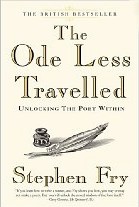The Ode Less Travelled: Unlocking the Poet Within (2006)
by Stephen Fry
comments by Ariadne Unst
Contents
Part 1. Metre.
- How we speak. Meet Meter. The great iamb.
The iambic pentameter.
- End-stopping, enjambment, and caesurea.
Weak endings, trochaic and pyrhhic substitutions.
Substitutions.
- More metres: four beats ot the line. Mixed feet.
- Ternary feet: the dactyl, the molossus and tribach,
the amphibrach, the amphimacer, quaternary feet.
- Anglo-Saxon attitudes. Sprung rhythm.
- Syllabic verse.
Ends with a table of metrical feet.
Part 2. Rhyme.
- The basic categories of rhyme. Partial Rhymes.
Feminine and triple rhymes. Rich rhyme.
- Rhyming arrangements.
- Good and bad rhyme?
A thought experiment.
Rhyming practice and rhyming dicrionaries.
Ends with a summary of rhyme categories.
Part 3. Form.
- The stanza. What is form and why bother with it?
- Stanzaic variations. Open forms: terza rima, the quatrain, the rubai,
rhyme royal, ottava rima,
Spenserian stanza.
Adopting and adapting.
- The ballad.
- Heroic verses.
- The ode: sapphic, pindaric, horatian, the lyric ode, anacreontics.
- Closed forms: The villanelle.
The Pantoum.
The ballade.
- More closed forms: rondeau redoublé,
rondel, roundel, rondelet, roundelay, triolet, kyrielle.
- Comic verse: cento, the clerihew, the limerick.
Reflections on comic and impolite verse.
Light verse. Parody.
- Exotic forms:
haiku, senryu,
tanka.
Ghazal. Luc bat. Tanaga.
- The
sonnet: Petrachan and Shakespearean.
Curtal and caudate sonnets.
Sonnet variations and romantic duels.
- Shaped verse. Pattern poems.
Silly, silly forms.
Acrostics.
Part 4. Diction and poetics today.
- The whale. The cat and the act.
Madeline. Diction.
Being alert to language.
- Poetic vices.
Ten habits of successful poets that they don't teach you at Harvard Poetry School ...
Getting noticed.
Poetry today.
Goodbye.
Ends with:
- Incomplete glossary of poetic terms.
- Appendix — Arnaud's Algorithm
- Acknowledgements.
- Further reading suggestions.
[Thanks for visiting.]

 Index of Poetry.
Index of Poetry.
 Highlights for Poetry.
Highlights for Poetry.
 Books of Poetry Form.
Books of Poetry Form.
 How to Write Poetry.
How to Write Poetry.
 Haibun.
Haibun.
 Haiku.
Haiku.
 Hay(na)ku.
Hay(na)ku.
 Rengay.
Rengay.
 Tanka.
Tanka.
 Concrete.
Concrete.
 Ghazal.
Ghazal.
 Lai.
Lai.
 Pantoum.
Pantoum.
 Rondeau.
Rondeau.
 Rubáiyát.
Rubáiyát.
 Sestina.
Sestina.
 Skaldic verse.
Skaldic verse.
 Sonnet.
Sonnet.
 Terza rima.
Terza rima.
 Triolet.
Triolet.
 Tritina.
Tritina.
 Villanelle.
Villanelle.
 El Poema Concreto.
El Poema Concreto.
 Books of Poetry Form.
Books of Poetry Form.

